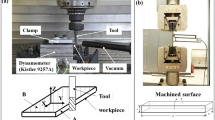Abstract
3D evaluation method of cutting surface topography for C/Ph composites was established. The cutting surface was measured by Talyscan 150, using 3D non-contact measurement. Through the results of 2D and 3D roughness evaluating for C/Ph composite and Duralumin, the 2D evaluation method of the cutting surface topography of C/Ph composite loses a lot of information, the characteristics of the surface topography of C/Ph composite can be comprehensively and authentically evaluated only by 3D evaluation method. Furthermore, 3D amplitude and spatial parameters were adopted to evaluate the surface. The results show that: the topography of the C/Ph composite is anisotropic, there are more valleys in the machined surface of C/Ph than that of duralumin, and there are not obvious feeding textures for C/Ph, which indicates the machining mechanism is different from the metal. In conclusion, the topography of the C/Ph composite cutting surface is anisotropic; the cutting surface of C/Ph composite needs 3D evaluation method.
Similar content being viewed by others
Reference
F Romano, J U Fiori Mercurio. Structural Design and Test Capability of A CFRP Aileron[J]. Composite Structures, 2009, 88(3): 333–341
P S Sreejith, R Krisnamurthy, S K Malhotra. Effect of Specific Cutting Pressure and Temperature During Machining of Carbon/Phenolic Ablative Composite Using PCBN Tools [J]. Journal of Materials Processing Technology, 2007, 183(1):88–95
Z L Wang, Y C Li, T Zhang, et al. Study on Mechani cal Properties of Carbon/Phenolic Composites [J]. Mechanics of Materials, 2008, 40(4–5): 418–426
Dong Chang Park, Seong Su Kim, Byung Chul Kim, et al. Wear Characteristics of Carbon-Phenolic Woven Composites Mixed with Nano-Particles[J]. Composite Structures, 2006, 74(1):89–98
Y M Quan, B Y Ye. Machined Surface Texture and Roughness of Composites[J]. Acta Materiae Composite Sinica, 2001, 18(4): 128–131
X Liu, V Piotter. Mapping Micro-mechanical Properties of Carbon-filled Polymer Composites by TPM[J]. Precision Engineering, 2007, 31(2): 162–168
P J Sullivan, L Blunt. Three-dimension Characterizatio of Indentation Topography: Visual Characterization[J].Wear, 1992, 159(2): 207–222
N Senin, M Ziliotti, R Groppetti. Three-dimensional Surface Topography Segmentation Through Chustering [J]. Wear, 2007, 262(3–4): 395–410
W P Dong, P J Sullivan, K J Stout. Comprehensive Study of Parameters for Characterising Three-dimensional Surface Topography I: Some Inherent Properties of Parameter Variation[J]. Wear, 1992, 159: 161–171
W P Dong, P J Sullivan, K J Stout. Comprehensive Study of Parameters for Characterising Three-dimensional Surface Topography II: Statistical Properties of Parameter Variation[J]. Wear, 1993, 167:9–21
W P Dong, P J Sullivan, K J Stout. Comprehensive Study of Parameters for Characterising Three-dimensional Surface Topography III: Parameters for Characterising Amplitude and Some Functional Properties[J]. Wear, 1994, 178(1–2):29–43
W P Dong, P J Sullivan, K J Stout. Comprehensive Study of Parameters for Characterising Three-dimensional Surface Topography IV: Parameters for Characterising Spatial and Hybrid Properties[J]. Wear, 1994, 178(1–2):45–60
E Mainsah, K J Stout. Report on the Second International Workshop on the Development of Method for Characterisation of Roughness in 3D[R]. Official Report, Circulated by BCR, May 1993
K J Sout. Development of Method for the Characterization of Roughness on Three Dimensions[M]. London: Penton Press, 2000
F L Zhao F, C Z Ai, D J Yang. Study on the Evalution Method and Evaluation Parameters of Cutting Surface Roughness of Carbon/Carbon Composite[J]. ACTA Meterologica Sinica, 2006, 27(3):206–211
D J Yang, C Z Ai, F L Zhao. Comparison of 2D Analysis and 3D Analysis on Turning Surface of Composites[J]. Machinery Design and Manufacture, 2006, 1:133–134
Author information
Authors and Affiliations
Corresponding author
Additional information
Funded by the National Natural Science Foundation of China(No.50875036)
Rights and permissions
About this article
Cite this article
Zhou, P., Zhao, F. 3D evaluation method of cutting surface topography of carbon / phenolic (C/Ph) composite. J. Wuhan Univ. Technol.-Mat. Sci. Edit. 26, 459–463 (2011). https://doi.org/10.1007/s11595-011-0249-6
Received:
Accepted:
Published:
Issue Date:
DOI: https://doi.org/10.1007/s11595-011-0249-6




